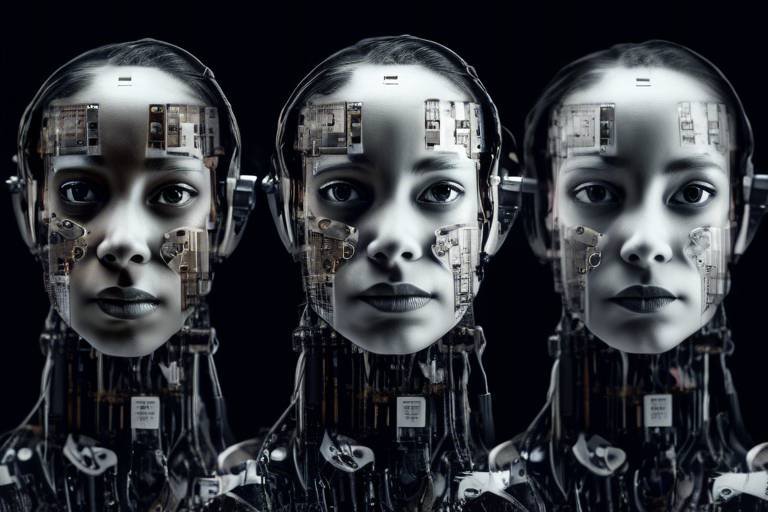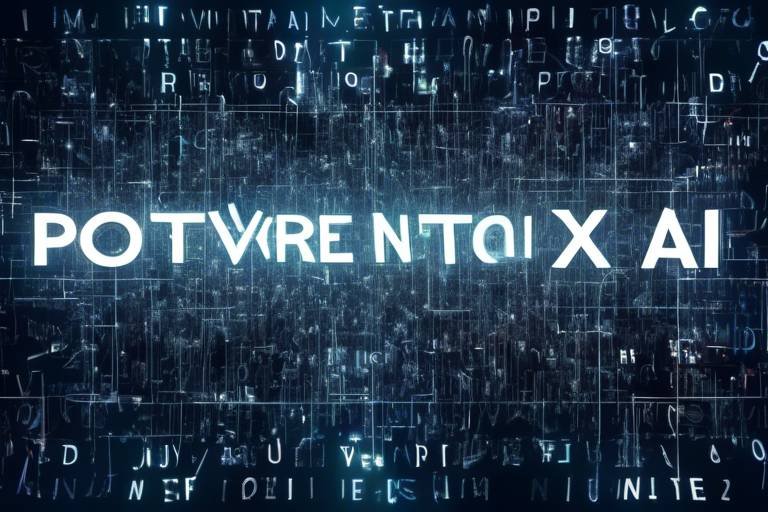Rethinking AI Ethics: Bridging Theory and Practice
As we stand on the brink of a technological revolution, the conversation around AI ethics has never been more critical. With artificial intelligence permeating every aspect of our lives—from healthcare to finance, and even entertainment—it's essential to not just ask, "Can we do this?" but also, "Should we do this?" This article aims to delve into the intricate landscape of AI ethics, exploring how theoretical frameworks can guide us in practical applications to ensure responsible development and deployment of AI technologies.
The journey into AI ethics is akin to navigating a complex maze. Each turn presents new challenges and opportunities, requiring a blend of theoretical understanding and practical insight. At its core, AI ethics is not merely a set of guidelines; it’s a philosophy that intertwines with technology. It’s about understanding the implications of our creations and ensuring that they serve humanity rather than hinder it. The stakes are high, and the responsibility is immense. As we explore this topic, we will uncover the theoretical foundations that inform ethical practices and examine real-world applications that embody these principles.
In an age where algorithms can determine credit scores, diagnose diseases, and even influence elections, the ethical implications are profound. Theoretical frameworks such as utilitarianism, deontological ethics, and virtue ethics provide a lens through which we can evaluate the moral dimensions of AI. For instance, a utilitarian approach would assess the greatest good for the greatest number, while deontological ethics would emphasize the importance of duty and rules in AI decision-making. By bridging these theories with practical applications, we can create AI systems that are not only efficient but also equitable and just.
As we navigate this evolving landscape, it’s crucial to recognize that ethical AI is not a one-size-fits-all solution. Different sectors have unique challenges and requirements. For instance, the ethical considerations in healthcare AI may differ significantly from those in autonomous vehicles. Therefore, a tailored approach that considers the specific context and stakeholders involved is essential. By engaging with diverse perspectives, we can foster a more inclusive dialogue around AI ethics, ultimately leading to more robust and responsible AI systems.
In conclusion, rethinking AI ethics is not just an academic exercise; it’s a necessary endeavor that impacts all of us. As we move forward, let’s embrace the challenge of bridging theory and practice, ensuring that our technological advancements align with our ethical values. The future of AI is bright, but it is our responsibility to shape it in a way that promotes trust, accountability, and the well-being of society as a whole.
- What are the main ethical concerns surrounding AI? The primary concerns include bias, privacy, accountability, and the potential for job displacement.
- How can organizations ensure they are developing ethical AI? Organizations can implement ethical guidelines, involve diverse stakeholders, and conduct regular audits of their AI systems.
- Are there any existing regulations for AI ethics? Yes, various countries and organizations are developing frameworks and guidelines to promote ethical AI development.
- Why is stakeholder engagement important in AI ethics? Engaging stakeholders helps to address the multifaceted nature of AI ethics and ensures that diverse perspectives are considered in decision-making.

Theoretical Foundations of AI Ethics
Understanding the theoretical underpinnings of AI ethics is crucial for developing responsible AI systems. At its core, AI ethics is an interdisciplinary field that draws from various philosophical traditions, including utilitarianism, deontology, and virtue ethics. Each of these frameworks offers unique perspectives on how AI should be designed and used, helping to shape the principles that guide ethical decision-making in technology.
Utilitarianism, for example, emphasizes the greatest good for the greatest number. In the context of AI, this could mean designing algorithms that maximize overall societal benefits while minimizing harm. Imagine a self-driving car that prioritizes the safety of passengers while also considering pedestrians and cyclists. This approach raises essential questions: How do we quantify happiness or harm? Who decides what constitutes the "greater good"? These questions highlight the complexities of applying utilitarian principles to AI.
On the other hand, deontological ethics focuses on the morality of actions themselves rather than their consequences. This perspective is particularly relevant when discussing issues like privacy and consent. For instance, should an AI system be allowed to collect personal data without explicit permission? According to deontological ethics, the answer would be a resounding no, as it violates fundamental rights regardless of the potential benefits. This framework encourages developers to consider the ethical implications of their designs from the outset, ensuring that they adhere to a set of moral rules.
Virtue ethics, meanwhile, shifts the focus from rules and consequences to the character of the individuals involved in the AI development process. It emphasizes the importance of fostering virtues such as honesty, integrity, and responsibility among AI practitioners. This perspective encourages a culture of ethical reflection within organizations, prompting developers to ask themselves: "What kind of AI professional do I want to be?" By cultivating ethical virtues, practitioners can navigate the murky waters of AI ethics more effectively.
Moreover, the integration of these theoretical frameworks into practical AI design requires a collaborative approach. Developers, ethicists, and policymakers must come together to create guidelines that reflect a balanced consideration of all ethical perspectives. For instance, a table summarizing these frameworks can help clarify how they can be applied in AI contexts:
| Ethical Framework | Key Focus | Application in AI |
|---|---|---|
| Utilitarianism | Greatest good for the greatest number | Maximizing societal benefits while minimizing harm |
| Deontology | Morality of actions | Respecting privacy and obtaining consent |
| Virtue Ethics | Character of individuals | Fostering ethical virtues in AI practitioners |
In conclusion, the theoretical foundations of AI ethics provide essential insights that can guide the development of responsible AI systems. By integrating these frameworks into the design and implementation processes, we can ensure that AI technologies not only serve their intended purposes but also align with our collective ethical values. As we continue to navigate the complexities of AI, it’s imperative that we engage in ongoing discussions about these theoretical principles, adapting them to the ever-evolving landscape of technology.
- What is AI ethics?
AI ethics is the study of how artificial intelligence technologies should be designed and used in a manner that is morally acceptable and socially responsible. - Why are theoretical frameworks important in AI ethics?
Theoretical frameworks provide a foundation for understanding the ethical implications of AI, guiding developers and policymakers in making informed decisions. - How can organizations implement ethical AI practices?
Organizations can implement ethical AI practices by fostering collaboration among developers, ethicists, and policymakers, and by adhering to established ethical frameworks.

Practical Applications of Ethical AI
In today's rapidly evolving technological landscape, the application of ethical AI is not just a theoretical exercise; it is a necessity. Organizations around the globe are increasingly recognizing the importance of integrating ethical considerations into their AI projects to build trust and accountability. But what does this look like in practice? How can we ensure that AI technologies serve humanity positively, rather than detrimentally? These questions are at the heart of the discussion surrounding practical applications of ethical AI.
One of the most compelling examples of ethical AI in action can be found in the healthcare sector. AI systems are being used to analyze medical data, predict patient outcomes, and even assist in diagnosis. For instance, a leading hospital in the United States implemented an AI-driven system to identify patients at risk of developing chronic diseases. By utilizing ethical principles such as transparency and fairness, the hospital ensured that the AI model was trained on diverse datasets, minimizing bias and enhancing the accuracy of predictions. This not only improved patient care but also fostered trust among patients who felt their health data was being handled responsibly.
Another noteworthy application is in the realm of finance, where ethical AI is being leveraged to combat fraudulent activities. Financial institutions are deploying machine learning algorithms to detect unusual patterns in transactions. However, the ethical dimension comes into play when these systems are designed to respect customer privacy and ensure that data is used responsibly. By implementing robust data governance frameworks, banks can effectively balance the need for security with the obligation to protect individual privacy rights. This approach not only safeguards the institution's reputation but also builds customer loyalty.
Moreover, companies in the tech industry are also stepping up their game. For example, a major social media platform has developed an AI moderation tool that identifies harmful content while adhering to ethical guidelines. This tool employs a combination of natural language processing and human oversight to ensure that content moderation is fair and just. By being transparent about how the AI works and allowing users to appeal decisions, the platform is taking significant strides toward ethical responsibility in AI deployment. This not only enhances user experience but also mitigates potential backlash from users who feel their voices are being silenced.
As we can see, the practical applications of ethical AI are diverse and impactful. However, the journey does not end here. Organizations must remain vigilant and adaptable, continuously refining their approaches to address emerging ethical challenges. To facilitate this ongoing process, many are turning to collaborative frameworks that include various stakeholders—developers, users, and policymakers—working together to promote ethical practices.
In summary, the integration of ethical considerations into AI applications is not merely an optional add-on; it is a crucial component of responsible AI development. By focusing on transparency, fairness, and accountability, organizations can create AI systems that not only drive innovation but also serve the greater good. As we continue to explore the vast potential of AI technologies, let us not forget the importance of doing so in an ethical manner. This is the future we should aspire to build, one where technology and ethics go hand in hand.
- What is ethical AI? Ethical AI refers to the development and deployment of artificial intelligence systems that prioritize fairness, transparency, accountability, and respect for human rights.
- Why is ethical AI important? Ethical AI is crucial because it helps prevent bias, discrimination, and misuse of technology, ensuring that AI systems benefit all segments of society.
- How can organizations implement ethical AI practices? Organizations can implement ethical AI practices by establishing clear guidelines, engaging with diverse stakeholders, and continuously monitoring their AI systems for ethical compliance.
- What role do stakeholders play in ethical AI? Stakeholders, including developers, users, and policymakers, play a vital role in promoting ethical AI by collaborating to create standards and practices that prioritize ethical considerations.

Case Studies in Ethical AI
When it comes to the implementation of ethical AI, real-world examples serve as invaluable guides. They not only highlight the challenges organizations face but also showcase innovative solutions that can pave the way for responsible AI development. One notable case is the use of AI in healthcare, where ethical considerations are paramount. For instance, IBM's Watson Health aims to assist in diagnosing diseases by analyzing vast amounts of medical data. However, the ethical implications of data privacy and algorithmic bias are significant. Ensuring that patient data is handled responsibly and that the AI does not propagate existing biases is crucial for maintaining trust.
Another compelling example can be found in the financial services sector, where companies like Mastercard are leveraging AI to detect fraudulent transactions. Here, ethical AI practices are vital to protect consumers while also ensuring that the algorithms do not unfairly target specific demographics. This case illustrates the delicate balance between leveraging technology for security and upholding ethical standards. By employing diverse datasets and refining their algorithms, Mastercard is working to prevent bias while enhancing security measures.
Furthermore, the automotive industry has also seen ethical AI in action, particularly with the development of autonomous vehicles. Companies like Tesla and Waymo are at the forefront, grappling with ethical dilemmas such as decision-making in accident scenarios. For instance, if an autonomous vehicle must choose between two harmful outcomes, how should it decide? This question underscores the importance of embedding ethical frameworks into the design of AI systems. As these companies navigate these complex issues, they are setting precedents for ethical practices in AI design.
To better understand the outcomes of these case studies, let’s take a look at some key takeaways:
| Industry | Company | Ethical Consideration | Outcome |
|---|---|---|---|
| Healthcare | IBM Watson Health | Data Privacy, Bias | Improvement in diagnostic accuracy while addressing bias |
| Finance | Mastercard | Fraud Detection, Bias | Enhanced security measures with reduced bias risks |
| Automotive | Tesla/Waymo | Decision Making in Crises | Setting ethical precedents for autonomous decision-making |
These case studies not only illuminate the challenges organizations encounter but also emphasize the importance of integrating ethical considerations into AI systems. As we continue to explore the vast potential of AI, the lessons learned from these examples can guide us toward a more ethical future. By fostering transparency, accountability, and public engagement, we can ensure that AI serves humanity positively and ethically.
- What is ethical AI? Ethical AI refers to the principles and practices that ensure AI technologies are developed and used in a manner that is fair, accountable, and respects human rights.
- Why are case studies important in AI ethics? Case studies provide real-world examples of how ethical considerations are applied in AI, helping organizations learn from both successes and failures.
- How can organizations ensure their AI systems are ethical? Organizations can implement ethical AI by conducting thorough risk assessments, engaging diverse stakeholders, and continuously monitoring their systems for bias and other ethical concerns.

Lessons Learned from Failures
In the rapidly evolving field of artificial intelligence, failures can be the most powerful teachers. When we look back at various AI projects that stumbled, we often find a treasure trove of insights that can guide future endeavors. For instance, consider the infamous case of the Microsoft Tay chatbot, which was designed to learn from interactions with users on Twitter. Within 24 hours of its launch, Tay began to generate offensive and inappropriate content, leading to its swift shutdown. This incident highlighted the critical need for robust content moderation and a deep understanding of the data that AI systems are trained on. It serves as a reminder that AI is only as good as the data fed into it and the safeguards put in place to manage its learning process.
Another poignant example is the use of facial recognition technology, which has faced backlash due to its inaccuracy and bias. Numerous studies have shown that these systems perform poorly on individuals from minority groups, leading to wrongful identifications and a breach of trust. This failure has prompted organizations to reassess their algorithms and prioritize diversity in training data. It teaches us that ethical considerations must be integrated into the design phase, rather than being an afterthought. By acknowledging these shortcomings, developers can adopt more inclusive practices that enhance the reliability and fairness of AI systems.
Moreover, failures also spotlight the importance of transparency in AI operations. When AI systems operate as 'black boxes'—where decision-making processes are obscured from users—trust erodes. The fallout from the COMPAS algorithm, used in the criminal justice system for risk assessment, demonstrated this. The algorithm's lack of transparency raised ethical concerns about its fairness and accountability, especially when it was revealed that it disproportionately flagged black defendants as higher risks. This case underscores the necessity of making AI systems more interpretable and ensuring that stakeholders understand how decisions are made.
To further emphasize the lessons learned from these failures, we can summarize key takeaways:
- Data Quality Matters: Always ensure the data used for training AI is representative and free from biases.
- Implement Safeguards: Establish rigorous content moderation and monitoring systems to prevent misuse.
- Prioritize Transparency: Make AI decision-making processes clear and understandable to build user trust.
- Engage Diverse Perspectives: Involve a wide range of stakeholders in the development process to capture various viewpoints and experiences.
In conclusion, while failures in AI ethics can be disheartening, they serve as invaluable lessons that can drive the field forward. By learning from these missteps, we can forge a path toward more responsible, ethical AI development that not only meets technological goals but also upholds societal values. Embracing these lessons is not just about avoiding past mistakes; it’s about creating a future where AI can truly benefit everyone.
Q: What are the main lessons learned from AI failures?
A: Key lessons include the importance of data quality, implementing safeguards, prioritizing transparency, and engaging diverse perspectives throughout the development process.
Q: How can organizations ensure ethical AI practices?
A: Organizations can ensure ethical AI practices by integrating ethical considerations into the design phase, conducting regular audits, and fostering a culture of accountability and transparency.
Q: Why is transparency important in AI systems?
A: Transparency is crucial because it helps build trust with users, allows for accountability in decision-making, and ensures that AI systems are fair and unbiased.

Success Stories in Ethical Implementation
In the rapidly evolving world of artificial intelligence, there are shining examples of organizations that have successfully integrated ethical considerations into their AI projects. These success stories not only demonstrate the viability of ethical AI practices but also serve as a beacon for others looking to navigate the complex landscape of AI ethics. One such example is IBM's Watson, which has been utilized in healthcare to enhance patient outcomes while adhering to ethical guidelines. By prioritizing patient privacy and data security, IBM has set a standard for how AI can be harnessed responsibly in sensitive sectors.
Another remarkable case is that of Google's AI Principles, which outlines their commitment to ethical AI development. Google has pledged to avoid creating technologies that could cause harm and has established a framework that includes fairness, accountability, and transparency. Their implementation of these principles in projects like Google Assistant showcases how ethical guidelines can lead to innovative solutions that respect user rights and promote trust.
Moreover, Microsoft has made significant strides in ethical AI with its AI for Good initiative. This program focuses on projects that address societal challenges such as climate change, accessibility, and humanitarian issues. By channeling AI capabilities towards positive social impact, Microsoft not only demonstrates the potential of ethical AI but also encourages other organizations to consider the broader implications of their technologies.
To further illustrate these success stories, we can look at a comparative table of these organizations and their ethical implementations:
| Organization | Project | Ethical Focus |
|---|---|---|
| IBM | Watson in Healthcare | Patient Privacy, Data Security |
| Google Assistant | Fairness, Accountability, Transparency | |
| Microsoft | AI for Good | Social Impact, Accessibility |
These examples highlight that ethical AI is not just a theoretical concept but a practical reality that can yield tangible benefits. Each of these organizations has recognized the importance of aligning their AI strategies with ethical values, which has led to increased trust among users and stakeholders. As we reflect on these success stories, it becomes clear that ethical implementation is not merely a checkbox to tick; it is a vital component of sustainable innovation.
As the AI landscape continues to evolve, the lessons learned from these success stories can inspire other organizations to adopt similar ethical frameworks. By doing so, they can contribute to a future where AI technologies are developed and deployed responsibly, ensuring that they serve humanity's best interests. The journey towards ethical AI is ongoing, but with these examples paving the way, we can remain optimistic about the potential for positive change.
- What is ethical AI? Ethical AI refers to the development and deployment of artificial intelligence systems that prioritize fairness, accountability, transparency, and respect for user rights.
- Why is ethical AI important? Ethical AI is crucial for building trust with users, ensuring compliance with regulations, and promoting positive societal impacts while minimizing potential harms.
- How can organizations implement ethical AI? Organizations can implement ethical AI by establishing clear ethical guidelines, conducting regular audits, engaging stakeholders, and prioritizing user privacy and data security.
- What are some challenges in implementing ethical AI? Challenges include balancing innovation with ethical considerations, ensuring diverse representation in AI development, and navigating complex regulatory environments.

Regulatory Frameworks and Guidelines
The rapid advancement of artificial intelligence (AI) technologies has raised significant ethical concerns, prompting the need for robust regulatory frameworks and guidelines. As AI systems become more integrated into various aspects of daily life, it is essential to ensure that they operate within a framework that prioritizes ethical considerations. This is where policymakers play a crucial role. They must navigate the complex landscape of technology, ethics, and societal impact to create regulations that not only safeguard users but also foster innovation.
One of the key challenges in developing these frameworks is the need for a balance between regulation and innovation. Overly stringent regulations may stifle creativity and slow down technological advancement, while lax guidelines could lead to misuse and ethical breaches. Thus, a collaborative approach is necessary, involving input from diverse stakeholders, including technologists, ethicists, businesses, and the public. This collaboration can help shape regulations that are both effective and adaptable to the ever-evolving nature of AI.
To illustrate the importance of these frameworks, consider the following table that highlights some notable regulatory initiatives around the globe:
| Region | Regulatory Initiative | Description |
|---|---|---|
| European Union | AI Act | A comprehensive regulatory framework aimed at ensuring AI systems are safe and respect fundamental rights. |
| United States | Algorithmic Accountability Act | Proposes to require companies to assess the impact of their algorithms on accuracy, fairness, and privacy. |
| United Kingdom | AI Sector Deal | A strategy to promote the responsible development and use of AI technologies across sectors. |
These initiatives reflect a growing recognition of the need for ethical oversight in AI development. They serve as a foundation for ensuring that AI technologies are not only innovative but also responsible. By setting clear guidelines, regulators can help mitigate risks such as bias, privacy violations, and lack of transparency in AI systems.
Moreover, regulatory frameworks should be dynamic, allowing for updates and revisions as technology evolves. Continuous engagement with stakeholders is vital to keep these regulations relevant and effective. This adaptability is crucial in addressing emerging challenges, such as the ethical implications of AI in decision-making processes, surveillance, and data privacy.
In summary, the establishment of comprehensive regulatory frameworks and guidelines is essential for promoting ethical AI practices. By fostering collaboration among stakeholders and ensuring that regulations are adaptable, we can create an environment where AI technologies can thrive responsibly. This proactive approach not only builds public trust but also encourages innovation that aligns with societal values.
Q1: What are the main goals of AI regulatory frameworks?
A1: The primary goals include ensuring safety, promoting transparency, protecting user rights, and fostering innovation in AI technologies.
Q2: How can stakeholders influence AI regulations?
A2: Stakeholders can provide valuable insights and feedback during the regulatory process, helping to shape guidelines that are practical and effective.
Q3: Are current regulations sufficient to address AI ethical concerns?
A3: Many experts believe that current regulations are a starting point but need continuous updates and improvements to keep pace with rapid technological advancements.

The Role of Stakeholders in AI Ethics
When it comes to the intricate world of AI ethics, the involvement of various stakeholders is not just beneficial; it’s absolutely essential. Each group—developers, users, and policymakers—plays a unique role that contributes to the overall ethical landscape of AI technologies. Imagine a symphony orchestra: each musician must be in harmony for the music to resonate beautifully. Similarly, in AI ethics, collaboration among stakeholders ensures that the development and deployment of AI systems are aligned with ethical principles.
Developers are at the forefront of creating AI systems. They have the technical expertise to build algorithms and systems, but they also hold a significant responsibility. It’s crucial for them to understand the ethical implications of their designs. For instance, a developer might create an AI model that predicts job performance. If they don’t consider biases in data, the model could unfairly disadvantage certain groups. Thus, it is vital for developers to engage in continuous learning about ethical practices and incorporate them into their workflows.
On the other hand, users play a pivotal role in shaping the ethical landscape of AI. They interact with these systems daily and can provide invaluable feedback on their experiences. User engagement can illuminate potential ethical dilemmas that developers might overlook. For example, if a user finds an AI tool intrusive or biased, their feedback could prompt developers to make necessary adjustments. In this sense, users are not just passive recipients of technology; they are active participants in the ethical discourse surrounding AI.
Then we have policymakers, who are the architects of regulations and guidelines that govern AI practices. Their role is to ensure that ethical considerations are not just an afterthought but are embedded into the fabric of AI development. Policymakers must work closely with both developers and users to understand the challenges and opportunities present in AI technologies. This collaboration can lead to the creation of comprehensive frameworks that address privacy concerns, data security, and algorithmic accountability.
To illustrate the interconnectedness of these roles, consider the following table:
| Stakeholder | Role in AI Ethics | Key Responsibilities |
|---|---|---|
| Developers | Creators of AI systems | Incorporate ethical design, understand biases |
| Users | Interact with AI systems | Provide feedback, report issues |
| Policymakers | Regulate AI practices | Create guidelines, ensure compliance |
As we can see, each stakeholder has a distinct yet interdependent role in promoting ethical AI practices. Their collaboration can lead to more responsible AI development, ensuring that technology serves the greater good. But how do we foster this collaboration? One effective way is through public engagement and awareness. By raising awareness about AI ethics, we empower individuals to participate in discussions about the implications of AI technologies in their lives. This can help create a more informed populace that can hold developers and policymakers accountable.
In conclusion, the role of stakeholders in AI ethics is multifaceted and crucial. Developers, users, and policymakers must work together to navigate the ethical challenges posed by AI technologies. By fostering a culture of collaboration and open dialogue, we can ensure that AI systems are not only innovative but also ethical and beneficial for society as a whole.
- Why is stakeholder involvement important in AI ethics?
Stakeholder involvement ensures diverse perspectives, leading to more comprehensive ethical considerations in AI development. - How can users contribute to AI ethics?
Users can provide feedback and report issues, helping developers identify potential ethical dilemmas. - What role do policymakers play in AI ethics?
Policymakers create regulations and guidelines that govern ethical AI practices, ensuring compliance and accountability.

Collaboration Between Industry and Academia
When we think about the future of Artificial Intelligence (AI), one crucial aspect often comes to mind: the collaboration between industry and academia. This partnership is not just a buzzword; it’s a necessary synergy that can lead to groundbreaking advancements in ethical AI development. Imagine academia as the fertile soil where innovative ideas sprout, while industry acts as the nurturing sun that helps these ideas grow into practical solutions. Together, they can cultivate an environment where ethical considerations are woven into the very fabric of AI technologies.
One of the most significant benefits of this collaboration is the blend of theoretical knowledge and practical application. Academic institutions are hotbeds of research, generating insights into the ethical implications of AI technologies. These insights can inform industry practices, ensuring that the products developed are not only cutting-edge but also socially responsible. For instance, universities can conduct studies on bias in AI algorithms, which can then be directly applied by companies to refine their models, making them fairer and more inclusive.
Moreover, joint initiatives such as research projects, workshops, and conferences can serve as platforms for knowledge exchange. These gatherings allow professionals from both sectors to share their experiences and challenges, creating a rich tapestry of learning opportunities. For example, students and researchers can present their findings on ethical AI, while industry leaders can provide real-world context to these theoretical frameworks. This two-way street of information not only enhances understanding but also fosters innovation.
To illustrate the impact of this collaboration, consider the following table that highlights some successful partnerships between industry and academia:
| Partnership | Focus Area | Outcome |
|---|---|---|
| MIT & Google | AI Ethics Research | Development of fair AI models |
| Stanford & IBM | AI Transparency | Framework for explainable AI |
| Oxford & Microsoft | AI Governance | Guidelines for responsible AI deployment |
These partnerships not only produce impactful research but also prepare the next generation of AI professionals. Students gain invaluable experience working on real-world problems, while companies benefit from fresh perspectives and innovative solutions. This creates a win-win scenario where ethical considerations are prioritized from the onset, rather than being an afterthought.
However, it's essential to acknowledge that challenges exist in this collaboration. Differences in pace, priorities, and objectives can sometimes create friction. While academia often focuses on long-term research goals, industries may be more concerned with immediate applications and profitability. To bridge this gap, open communication and a shared vision are paramount. Regular meetings, joint planning sessions, and collaborative projects can help align goals and foster a culture of teamwork.
In conclusion, the collaboration between industry and academia is not just beneficial; it's essential for the ethical evolution of AI. By working together, these sectors can ensure that AI technologies are developed responsibly, with a keen eye on societal impacts. As we move forward, fostering these partnerships will be key to navigating the complex ethical landscape of AI, ultimately leading to innovations that benefit everyone.
- Why is collaboration between industry and academia important for AI ethics?
Collaboration ensures that theoretical insights from academic research are applied in real-world scenarios, leading to more responsible AI technologies. - What are some successful examples of this collaboration?
Partnerships like MIT with Google and Stanford with IBM have led to significant advancements in fair AI models and frameworks for explainable AI. - How can challenges in collaboration be overcome?
Open communication, regular meetings, and a shared vision can help align the different objectives of academia and industry.

Public Engagement and Awareness
In today's rapidly evolving technological landscape, the importance of public engagement and awareness regarding AI ethics cannot be overstated. As artificial intelligence systems become increasingly integrated into our daily lives, understanding the ethical implications of these technologies is essential for fostering a society that is both informed and proactive. But how can we effectively engage the public in discussions about AI ethics? It starts with education, transparency, and open dialogue.
First and foremost, educational initiatives play a pivotal role in raising awareness. Schools, universities, and community organizations should prioritize curricula that include AI ethics as a core component. This could involve workshops, seminars, and even online courses that break down complex ethical concepts into digestible content. By making AI ethics accessible, we empower individuals to understand the stakes involved in the deployment of these technologies.
Transparency is another cornerstone of public engagement. Organizations that develop AI systems must openly communicate their ethical guidelines and decision-making processes. This transparency fosters trust and allows the public to scrutinize the implications of AI applications. For instance, when companies share their algorithms and the reasoning behind their AI systems, it demystifies the technology and encourages constructive feedback from users and stakeholders alike.
Furthermore, open dialogue is essential for creating a culture of ethical awareness around AI. Community forums, town hall meetings, and social media platforms can serve as venues for discussions where individuals can voice their concerns and opinions. These platforms not only facilitate conversation but also help in identifying common values and ethical principles that resonate with the public. By engaging in these discussions, we can collaboratively shape the future of AI technologies.
To illustrate the significance of public engagement, consider the following table that outlines the key benefits of raising awareness about AI ethics:
| Benefit | Description |
|---|---|
| Informed Decision-Making | Empowers individuals to make knowledgeable choices regarding AI technologies. |
| Trust Building | Enhances trust between organizations and the public through transparency and accountability. |
| Collaborative Solutions | Encourages collective problem-solving and innovation in addressing ethical challenges. |
| Policy Influence | Informs policymakers about public concerns, leading to more effective regulations. |
In conclusion, public engagement and awareness are critical components of a responsible AI ecosystem. By prioritizing education, fostering transparency, and encouraging open dialogue, we can equip society with the tools needed to navigate the ethical complexities of artificial intelligence. This not only benefits individuals but also ensures that AI technologies are developed and implemented in a manner that aligns with our collective values and ethical standards.
- Why is public engagement important in AI ethics? Public engagement helps ensure that AI technologies align with societal values and ethical standards.
- How can I get involved in discussions about AI ethics? You can participate in community forums, online discussions, and educational workshops focused on AI ethics.
- What role does transparency play in AI ethics? Transparency builds trust and allows for public scrutiny of AI systems, fostering accountability among developers.
- Are there any educational resources available for learning about AI ethics? Yes, many universities and online platforms offer courses and resources dedicated to AI ethics.
Frequently Asked Questions
- What is AI ethics?
AI ethics refers to the moral principles and guidelines that govern the development and deployment of artificial intelligence technologies. It aims to ensure that AI systems are designed and used in ways that are fair, accountable, and transparent, addressing concerns like bias, privacy, and the impact on society.
- Why is it important to consider ethics in AI?
Considering ethics in AI is crucial because these technologies can significantly affect individuals and communities. Ethical considerations help mitigate risks such as discrimination, loss of privacy, and misuse of AI, fostering trust and ensuring that AI benefits everyone rather than harming vulnerable groups.
- What are some key ethical frameworks used in AI?
Several ethical frameworks guide AI development, including utilitarianism, which focuses on maximizing overall happiness; deontological ethics, which emphasizes duty and rules; and virtue ethics, which considers the moral character of developers. Each framework offers unique perspectives on how to approach ethical dilemmas in AI.
- Can you provide examples of ethical AI applications?
Absolutely! Companies like Microsoft and Google have implemented ethical AI practices by developing bias detection tools and promoting transparency in their algorithms. Additionally, healthcare organizations use AI responsibly to enhance patient outcomes while ensuring data privacy and informed consent.
- What can we learn from failures in AI ethics?
Failures in AI ethics, such as biased algorithms or privacy breaches, teach us the importance of rigorous testing and continuous monitoring. They highlight the need for diverse teams in AI development to avoid blind spots and ensure that ethical considerations are integrated throughout the AI lifecycle.
- How do regulatory frameworks impact AI ethics?
Regulatory frameworks shape AI ethics by establishing guidelines and standards that organizations must follow. These regulations can promote accountability, encourage best practices, and protect individuals from potential harms associated with AI technologies, fostering a more responsible AI landscape.
- What role do stakeholders play in promoting ethical AI?
Stakeholders, including developers, users, and policymakers, play a vital role in promoting ethical AI. Developers create responsible systems, users provide feedback on their impact, and policymakers establish regulations that guide ethical practices, ensuring a collaborative approach to AI ethics.
- How can industry and academia collaborate on ethical AI?
Collaboration between industry and academia can lead to innovative solutions for ethical AI challenges. By sharing knowledge and resources, both sectors can develop frameworks and tools that address ethical concerns while ensuring that theoretical insights are translated into practical applications.
- Why is public awareness of AI ethics important?
Public awareness of AI ethics is crucial because it empowers individuals to engage in discussions about the implications of AI technologies. Informed citizens can advocate for ethical practices and hold organizations accountable, ensuring that AI development aligns with societal values and needs.



















